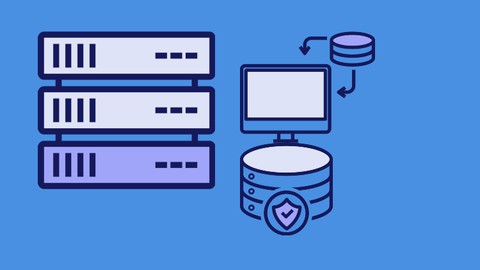
Database Engineer/DBA – (PostgreSQL, IBM-DB2, MariaDB,NoSQL)
Database Engineer/DBA – (PostgreSQL, IBM-DB2, MariaDB,NoSQL), available at $74.99, has an average rating of 4.68, with 191 lectures, based on 410 reviews, and has 31679 subscribers.
You will learn about Installing Database Servers Creating Databases Creating Tables Extracting and joining data from multiple tables Dropping and Truncating Tables Performing CRUD Operations Sorting and Filtering Data Creating Stored Procedures Querying database with various operators Creating Triggers Creating Views Implementing Database Security Backing up and restoring database Aggregating data with Aggregate Functions Analyzing data with Analytic Functions Creating NoSQL Databases Interacting with NoSQL Databases This course is ideal for individuals who are Beginner Database Engineers or Beginner Database Administrators or Beginner Data Analyst It is particularly useful for Beginner Database Engineers or Beginner Database Administrators or Beginner Data Analyst.
Enroll now: Database Engineer/DBA – (PostgreSQL, IBM-DB2, MariaDB,NoSQL)
Summary
Title: Database Engineer/DBA – (PostgreSQL, IBM-DB2, MariaDB,NoSQL)
Price: $74.99
Average Rating: 4.68
Number of Lectures: 191
Number of Published Lectures: 191
Number of Curriculum Items: 191
Number of Published Curriculum Objects: 191
Original Price: $64.99
Quality Status: approved
Status: Live
What You Will Learn
- Installing Database Servers
- Creating Databases
- Creating Tables
- Extracting and joining data from multiple tables
- Dropping and Truncating Tables
- Performing CRUD Operations
- Sorting and Filtering Data
- Creating Stored Procedures
- Querying database with various operators
- Creating Triggers
- Creating Views
- Implementing Database Security
- Backing up and restoring database
- Aggregating data with Aggregate Functions
- Analyzing data with Analytic Functions
- Creating NoSQL Databases
- Interacting with NoSQL Databases
Who Should Attend
- Beginner Database Engineers
- Beginner Database Administrators
- Beginner Data Analyst
Target Audiences
- Beginner Database Engineers
- Beginner Database Administrators
- Beginner Data Analyst
Database engineers design new databases based on company needs, data storage needs, and the number of users accessing the database. Monitor Databases and Programs. Database engineers continuously monitor databases and related systems to ensure high functionality.
Database administrator ensures that data is available, protected from loss and corruption, and easily accessible as needed. Also they oversee the creation, maintenance and security of your databases. manages, backs up and ensures the availability of the data.
PostgreSQL is commonly known as Postgres and it is also open source database. PostgreSQL is a powerful, open source object-relational database system.
IBM Db2 is a family of related data management products,including relational database servers, developed and marketed by IBM.
MariaDB is great for its open-source innovation and enterprise-grade reliability, as well as its modern relational database.
SQL -Structured Query Language is an internationally recognized language used to communicate and manipulate various database systems.
Data is everywhere and growing at a rapid rate. Most Software application we interact with daily deals with stored data . From our interaction with our banks to social media applications like Facebook and Instagram..
Due to the relevance and dependency on data , professionals that are skilled in SQL are always in high demand to help interact with various databases to help business intelligence and other sectors that relies on data.
NoSQL (Non-SQL or Not-only-SQL) databases are increasing in popularity due to the growth of data as they can store non-relational data on a super large scale, and can solve problems regular databases can’t handle. They are widely used in Big data operations. Their main advantage is the ability to handle large data sets effectively as well as scalability and flexibility issues for modern applications.
Course Curriculum
Chapter 1: PostgreSQL Setup
Lecture 1: Introduction
Lecture 2: What is PostgreSQL
Lecture 3: Minimum Installation Requirements
Lecture 4: Installing PostgreSQL on Windows
Lecture 5: Installing PostgreSQL on MacOS
Lecture 6: Installing PgAdmin Tool on MacOS
Lecture 7: Installing PostgreSQL on Linux
Lecture 8: Installing PgAdmin Tool on Linux
Lecture 9: Connecting to PostgreSQL Database Server
Lecture 10: Load Sample Database
Lecture 11: Loading Sample Database -Option 2
Lecture 12: Database Concepts
Lecture 13: Data Types
Chapter 2: PostgreSQL Database Objects
Lecture 1: Server Service
Lecture 2: Database
Lecture 3: Table
Lecture 4: Schema
Lecture 5: Tablespace
Lecture 6: Views
Lecture 7: Functions
Lecture 8: Cast and Operators
Lecture 9: Sequences
Lecture 10: Extensions
Chapter 3: PostgreSQL CRUD Operations
Lecture 1: What is CRUD
Lecture 2: What is SQL
Lecture 3: Create Database using pgadmin
Lecture 4: Create Table using pgadmin
Lecture 5: Create Table using SQL Statement
Lecture 6: Retrieve data with SELECT statement
Lecture 7: Using Subqueries
Lecture 8: Modify data using UPDATE Statement
Lecture 9: Remove data using DELETE Statement
Lecture 10: Add data using INSERT INTO Statement
Lecture 11: PostgreSQL Unique Constraint
Lecture 12: Filtering data with WHERE clause
Lecture 13: Retrieve all data from a table
Lecture 14: Retrieve data from a specific column
Lecture 15: Remove duplicate records
Lecture 16: Sorting data
Lecture 17: Grouping Data using GROUP BY Clause
Lecture 18: Using HAVING Clause
Lecture 19: Truncating Tables
Lecture 20: Stored Procedures
Chapter 4: PostgreSQL Operators
Lecture 1: Comparison Operators
Lecture 2: BETWEEN Operator
Lecture 3: NOT BETWEEN Operator
Lecture 4: LIKE OPERATOR
Lecture 5: NOT Operator
Lecture 6: OR Operator
Lecture 7: AND Operator
Lecture 8: Combining AND | OR Operator
Lecture 9: LIMIT Operator
Lecture 10: IN Operator
Lecture 11: UNION Operator
Lecture 12: UNION ALL Operator
Lecture 13: INTERSECT Operator
Lecture 14: EXCEPT Operator
Chapter 5: PostgreSQL Database Table Join
Lecture 1: Introduction to Table Joins
Lecture 2: INNER JOIN
Lecture 3: LEFT Join
Lecture 4: FULL OUTER Join
Lecture 5: CROSS Join
Lecture 6: NATURAL Join
Chapter 6: PostgreSQL Aggregate Functions
Lecture 1: Introduction to Aggregate Functions
Lecture 2: AVG Aggregate function
Lecture 3: COUNT Aggregate function
Lecture 4: MAX Aggregate function
Lecture 5: MIN Aggregate function
Chapter 7: PostgreSQL Analytic Functions
Lecture 1: SUM Aggregate function
Lecture 2: Introduction to Analytic Functions
Lecture 3: Creating sample tables
Lecture 4: Using AVG as window function
Lecture 5: ROW Number Functions
Lecture 6: RANK Functions
Lecture 7: DENSE RANK Functions
Lecture 8: First Value Function
Lecture 9: LAST Function
Lecture 10: LAG Function
Lecture 11: LEAD Function
Chapter 8: PostgreSQL Views
Lecture 1: Introduction to Views
Lecture 2: Benefits of views
Lecture 3: Creating views
Lecture 4: Modifying and removing views
Lecture 5: Updatable Views
Lecture 6: Creating Updatable Views
Lecture 7: Materialized Views
Lecture 8: Creating Materialized Views
Chapter 9: PostgreSQL Triggers
Lecture 1: Introduction to Triggers
Lecture 2: Creating your first trigger-part 1
Lecture 3: Creating your first trigger-part 2
Lecture 4: Creating your first trigger-part 3
Instructors
-

Bluelime Learning Solutions
Making Learning Simple
Rating Distribution
- 1 stars: 11 votes
- 2 stars: 13 votes
- 3 stars: 46 votes
- 4 stars: 146 votes
- 5 stars: 194 votes
Frequently Asked Questions
How long do I have access to the course materials?
You can view and review the lecture materials indefinitely, like an on-demand channel.
Can I take my courses with me wherever I go?
Definitely! If you have an internet connection, courses on Udemy are available on any device at any time. If you don’t have an internet connection, some instructors also let their students download course lectures. That’s up to the instructor though, so make sure you get on their good side!
You may also like
- Digital Marketing Foundation Course
- Google Shopping Ads Digital Marketing Course
- Multi Cloud Infrastructure for beginners
- Master Lead Generation: Grow Subscribers & Sales with Popups
- Complete Copywriting System : write to sell with ease
- Product Positioning Masterclass: Unlock Market Traction
- How to Promote Your Webinar and Get More Attendees?
- Digital Marketing Courses
- Create music with Artificial Intelligence in this new market
- Create CONVERTING UGC Content So Brands Will Pay You More
- Podcast: The top 8 ways to monetize by Podcasting
- TikTok Marketing Mastery: Learn to Grow & Go Viral
- Free Digital Marketing Basics Course in Hindi
- MailChimp Free Mailing Lists: MailChimp Email Marketing
- Automate Digital Marketing & Social Media with Generative AI
- Google Ads MasterClass – All Advanced Features
- Online Course Creator: Create & Sell Online Courses Today!
- Introduction to SEO – Basic Principles of SEO
- Affiliate Marketing For Beginners: Go From Novice To Pro
- Effective Website Planning Made Simple




















